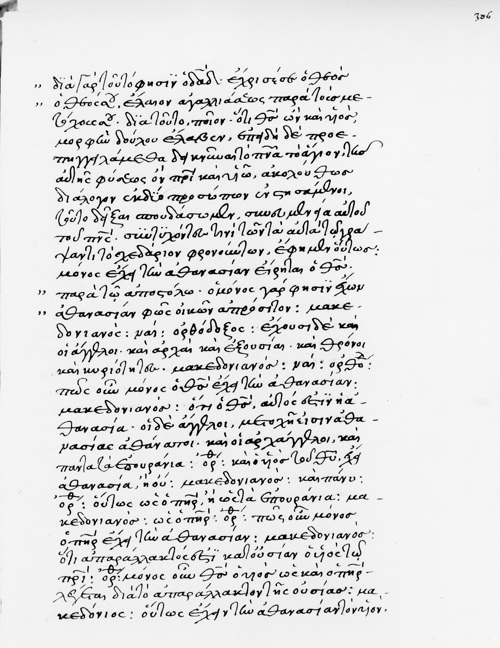

The Bancroft Library possesses one Greek manuscript dated 1569 that came to the campus as part of the Fernán-Núñez Collection acquired in 1984. Two known Greek scribes wrote the pages of this manuscript. Most of the pages are the work of Ioannes Mauromates, a native of Corfu who worked in Venice, Rome, Florence, and Bologna. The image below, showing folio 306, illustrates Mauromates' hand, a relatively disciplined 16th-century script which nevertheless shows features typical of late medieval Greek writing: abundance of ligatured letter-combinations, occasional ligature of an accent with its vowel, mixture of letters of exaggerated size with smaller letters of a more uniform dimension, coexistence of majuscule letter-forms with minuscule, cursive tau with its horizontal portion extending to the left only, use of nomina sacra abbreviations and a few other abbreviations.

The text is a treatise in dialogue form contra Macedonianos falsely ascribed to St. Athanasius (Migne, Patrologia Graeca 28, 1292-1329). Here is a transcription of the first twelve lines:
διὰ γὰρ τοῦτό φησιν ὁ δα(βὶ)δ, ἔχρισέ σε ὁ θεὸς
ὁ θεός σου, ἔλαιον ἀγαλλιάσεως παρὰ τοὺς με-
τόχους σου. διὰ τοῦτο, ποῖον· ὅτι θ(εὸ)ς ὢν καὶ υἱὸς,
μορφὴν δούλου ἔλαβεν, ἐπειδὴ δὲ προε-
πηγγειλάμεθα δεικνῦναι τὸ πν(εῦμ)α τὸ ἅγιον, τῆς
αὐτῆς φύσεως ὂν π(ατ)ρὶ καὶ υἱῶ, ἀκολούθως
διάλογον ἐκ δύο προσώπων ἐνστησάμενοι,
τοῦτο δεῖξαι σπουδάσωμεν, σὺν εὐμενεία αὐτοῦ
τοῦ πν(εύματο)ς. συντυχόντες τινὶ τῶν τὰ αὐτὰ τῷ γρά-
ψαντι τὸ σχεδάριον φρονούντων, ἔφημεν οὕτως·
μόνος ἔχει τὴν ἀθανασίαν εἴρηται ὁ θ(εὸ)ς
παρὰ τῷ ἀποστόλω· ὁ μόνος γάρ φησιν ἔχων
The other scribe represented by this manuscript is Andreas Darmarios, a native of Monembasia in the Peloponnese who lived in Venice but who traveled widely and was active in several Italian cities as well as in other European countries. The image below, showing folio 252, illustrates his hand, a much less attractive one featuring some extremely small letters (especially the vowels), a great deal of ligaturing, and some suspended abbreviated endings.

The text is a treatise in dialogue form de anima et resurrectione by Gregorius Nyssenus, falsely ascribed in this manuscript to St. Anastasius (Migne, Patrologia Graeca 46, 12-160). Here is a transcription of the first twelve lines:
φύσις, ἀπὸ γενεσεως εἰς θάνατον ἀεὶ διά τινος κι-
νήσεως προϊοῦσα τότε τῆς κινήσεως λήγουσα· ὅταν
καὶ τοῦ εἶναι παύσεται; ἡ δὲ κίνησις αὕτη
οὐ τοπική τίς ἐστι μετάστασις· οὐ γὰρ ἐκβαίν(ει)
ἑαυτὴν ἡ φύσις· ἀλλὰ δι’ ἀλλοιώσεως ἔχει τὴν
πρόοδον· ἡ δὲ ἀλλοίωσις ἕως ἂν ἦ τοῦτο ὃ λέγετ(αι)
οὐδέποτε ἐπὶ τοῦ αὐτοῦ μένει· πῶς γὰρ ἂν
ἐν ταυτότητι φυλαχθείη τὸ ἀλλοιούμενον· ἀλλ’ ὥσ
περ τὸ ἐπὶ τῆς θρυαλλίδος πῦρ, τῷ μὲν δοκεῖν
ᾀεὶ τὸ αὐτὸ φαίνεται· τὸ γὰρ συνεχὲς ἀεὶ
τῆς κινήσεως ἀδιάσπαστον αὐτὸ καὶ ἡνω-
μένον πρὸς ἑαυτὸ δείκνυσι. τῇ δὲ ἀληθεία πάντως